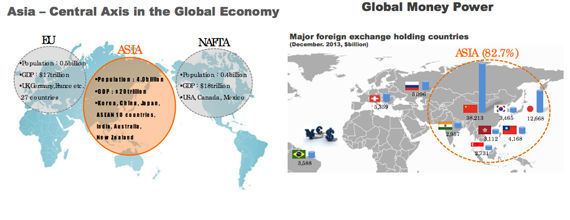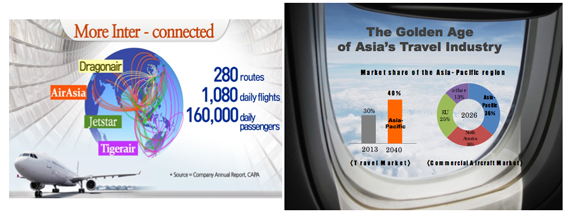Asia has been rapidly creating and accumulating wealth and knowledge. But in spite of these spectacular achievements and success, Asia is now faced with a renewed urgency to find an efficient solution for securing sustainable future growth.
With regard to this issue, I have proposed the concept of One Asia for a long time as a way to strengthen cooperation amongst Asian countries, thereby boosting its growth momentum. Then, how can we create powerful and efficient One Asia Momentum in order to contribute innovative values to the global economy? And how can we discover the momentum which will help Asia move one step forward? We need practical solutions for these difficult questions.
I have previously discussed with Prof. Jean-Claude Larreche from INSEAD about the "Momentum Effect" which is the secret weapon for an efficient and sustainable growth of corporations. We shared the view that the momentum strategy is to have an efficient self-sustaining growth by making waves which are sustainable. Now I think that the people of Asia are making new waves on which they can ride and go further. I personally believe that Asia shouldn't miss the opportunity to find and create a momentum effect and put it to work not only on the corporate and national level but throughout all of Asia as well.
The global economy is largely composed of the 3 economic regions: the US, EU and North Eastern Asia with each having similar economic sizes of 15~16 trillion dollars GDP. In particular, Europe put the Lisbon Treaty whose purpose is to advance political unity beyond economic integration into effect on Dec 1st, 2009 to counter the Pax-Americana of the United States. This phenomenon may in turn warrant and motivate the need for an integration momentum in Asia.
Asia holds huge potential with a population of 4 billion people and 20 trillion dollars worth of foreign exchange reserves which account for 82.7% of all foreign reserves around the world. In spite of all this great potential, Asia still finds it hard to form a single economic block like the US led NAFT or EU.

Why is it so difficult to integrate Asia? There are several reasons for Asia not being able to form economic integration.
Territorial disputes and unhealed wounds inflicted by past bloody wars in Asia have left lasting scars which still continue to this day. Additionally, it is hard to find a driving force for integration in Asia. Above all, major Asian powers can't make political compromises to build a basis for integration. The 3 major North Eastern Asian countries of Korea, China and Japan used to hold summit meetings regularly in the past. But now these occasions are discontinued since these countries are largely divided by conflicts over territorial disputes and unapologetic stances of the Japanese government for war crimes perpetrated during the 2nd world war. There is an issue with whether the EAS (East Asia Summit) member countries of India, Australia and New Zealand should be included as part of the One Asia integration.
Also, there are 5 hurdles to overcome for the One Asia integration.
First of all, there are on-going rivalries to have hegemony in Asia among the US, China and Japan. The United States and Japan are both uneasy about China's rapid growth. Japan which feels threatened about China's advancement tries to keep China in check. Adding to the tension, the United States' Pivot to Asian policy aims to strengthen the U.S- Japan alliance in order to contain China's growth. Even some other countries such as India, Vietnam and the Philippines are also afraid of the ever increasing Chinese military power. As the nationalism sentiments in Japan and China are flourishing, Korea was dragged into the "war on history" which completely halted the FTA negotiations among Korea, China, and Japan.
Second, the argument of the benefits regional integration can produce has lost its considerable support since EU, the largest economic block, which was regarded as the best example for Asia to emulate for its economic integration hasn't produced the expected economical and political advantages after the 2008 global financial crisis. The fact that only Germany was able to benefit from the EU integration while other EU countries suffered losses weakened the momentum for the creation of One Asia.
Third, different economic powers and an increasing gap between rich and poor countries can be an obstacle for the realization of One Asia. The only solution for maintaining the regional economic block is welfare programs with which affluent countries support poorer countries economically. This means wealthy countries have to collect more taxes from their own people for the betterment of the less fortunate neighboring countries, which will inevitably cause complaints from the people of the wealthy countries, leading to the collapse of the existing economic block. It is always hard for even the most affluent countries to continue to aid poor neighboring ones just to keep the economic block intact.
Forth, North Korea which is the most menacing threat to the peace of North Eastern Asia is another Achilles to the creation of One Asia. For the past 5 years, the negotiation to resolve North Korea's nuclear issue has been deadlocked due to differing positions between the 3 countries of Korea, US, Japan and China on how to end North Korea's ambition for their nuclear weapons development program.
Lastly, there has been no progress made on Currency Integration in Asia which is the prerequisite for the economic integration. In order to realize and advance the launch of Asia common currency, Asia's financial cooperation which started with the Chiang Mai Initiative needs to be further strengthened so that the nations in Asia could discuss increasing the size of a multinational monetary fund, building the Asia Monetary Fund and setting up the Asian version of rating agencies.
Despite these challenges, there are some encouraging signs for One Asia. There are about 300 routes which connect Asian countries and 160,000 passengers in the region who travel each day. These numbers demonstrate that Asian countries are becoming more interconnected. Also, relative importance of Asia in the international travel industry is increasing. There are predictions that Asia will make up about 40 percent of the global travel industry by 2030.

In addition, there are discussions about starting a project called Asian Highway to connect roads and railways of 32 Asian countries with 55 routes expanding 140,000km. When this project is complete, exchanges of personnel and products will be significantly increased, which will take us one step closer to the economic integration of Asia.

An oil hub project currently underway in Ulsan, the south eastern part of Korea to build crude oil storage facilities which can store up to 28 million barrels can play an important role in providing crude oil and oil products to neighboring countries, helping their economy grow.
We have to start from the bottom and work our way up the ladder. We need to fortify the foundation for One Asia integration by establishing Asia health institutes, Asia business schools, Asia medical schools, Asia law schools, and Asia statistics offices. We also need to introduce Pan-Asia standardization and set up a leadership course for young elites in Asia. We may begin launching the Asia Council which is the integrated parliament of Asian nations.
Also, Asia needs to fulfill its obligations and assume responsibilities to commensurate its economic power on the global stage. Nobel Prize winner, Robert Fogel, predicted that China's GDP would reach 123 trillion dollars which would be double that of the United States and EU combined in 2040. Since future wealth emanates from large populations, Asia which boasts 4 billion people has enormous potential. As such, it's time for Asia to secure an appropriate status by taking initiatives to address global issues such as climate change, food security and energy problems and to support undeveloped countries.
As we get closer to achieving "One Asia", Asian nations will be able to contribute more to the global economic recovery and to play a pivotal role in constructing the new world order. Now, Asia needs to become a primary figure in the global community. We need to develop diverse programs for further cooperation in Asia.
Asia has already begun its grand journey. We need to use this opportunity to create One Asia. One Asia is the future of Asian People.